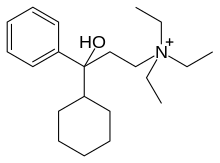Tridihexethyl
Tridihexethyl (which is commonly used as its chloride salt, tridihexethyl chloride) is an anticholinergic, antimuscarinic and antispasmodic drug. It may be used, usually in combination with other drugs, to treat acquired nystagmus[1] or peptic ulcer disease.[2] Many patients discontinue the drug because of unwanted side effects.
 | |
| Clinical data | |
|---|---|
| ATC code | |
| Identifiers | |
| |
| CAS Number | |
| PubChem CID | |
| DrugBank | |
| ChemSpider | |
| UNII | |
| ChEBI | |
| ChEMBL | |
| CompTox Dashboard (EPA) | |
| Chemical and physical data | |
| Formula | C21H36NO+ |
| Molar mass | 318.525 g·mol−1 |
| 3D model (JSmol) | |
| |
| |
| | |
It is also known as Pathilon or Propethonum. [3]
References
- Leigh RJ, Burnstine TH, Ruff RL, Kasmer RJ (November 1991). "Effect of anticholinergic agents upon acquired nystagmus: a double-blind study of trihexyphenidyl and tridihexethyl chloride". Neurology. 41 (11): 1737–41. doi:10.1212/wnl.41.11.1737. PMID 1944902. S2CID 23270800.
- "DB00505 (Tridihexethyl)". DrugBank.
- "Tridihexethyl". Mongabay.com. Archived from the original on 2007-11-15.
This article is issued from Wikipedia. The text is licensed under Creative Commons - Attribution - Sharealike. Additional terms may apply for the media files.